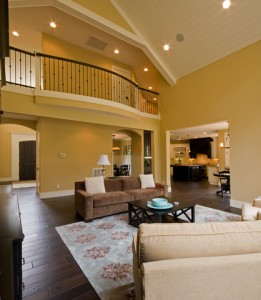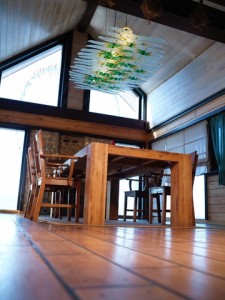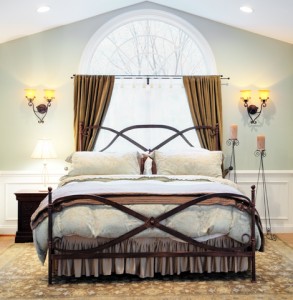Cathedral Ceiling Lighting: Architectural Detail and Design Challenges
Cathedral ceiling lighting can be challenging, but when done well can provide quality lighting and accent your architectural design.
Cathedral ceiling lighting is an exciting challenge. Cathedral ceilings are one of the most beautiful architectural details that one can have in the home, but lighting them is one of the trickiest types of lighting. There are two things that you will want to ensure when using cathedral ceiling lighting. First, you will want to make sure that you accent the ceiling itself. Unlike most ceilings, a cathedral or other vaulted ceiling is one to which you will want to draw attention. Second, you will want to light your room underneath the ceiling properly. Without a close and flat ceiling, however, this creates its own sets of difficulties. Here, I will discuss how to use cathedral ceiling lighting both beautifully and effectively.
Lighting the Cathedral Ceiling Itself

Notice how the inclusion of recessed lighting brings out the contours of the cathedral ceiling itself.
Using Central Beams: Many cathedral ceilings will include beams that cross where the standard ceiling would have been. This provides an excellent location for placing your cathedral ceiling lighting. Hide your light sources above the beams, and use them to illuminate your ceiling. Now, you should be careful here. If you put a track of lights across the middle beam, then you will be basically creating spots on your ceiling that can be unattractive. Instead, you should put the lights further from the center of your room, so that they strike the ceilings at an obtuse angle. This gives the effect of “washing” your ceiling, lighting evenly across your ceiling, rather than creating spots.
Using Wall Beams: Another option is to illuminate your ceiling from bars that run along the walls parallel to the center. If you can hide the light sources there, you can create washes of light that go across your ceiling in a V-pattern from each light source. This has the additional beautiful effect of resembling torchlight, giving your lighting a more classical feel perfect for your more classical architectural choice. The V-pattern also draws the eye upward, which is exactly the desired effect on visitors.
Whichever you choose, be sure to space your lighting sources evenly along your whole ceiling, as any asymmetry will warp your room and will hide the geometrical features of the cathedral ceiling.
Light Coming From the Cathedral Ceiling
Often, discussion of cathedral ceiling lighting focuses on how to compensate for the lack of a flat ceiling (I will discuss this myself in the minute), but first I will discuss how to use the cathedral ceiling itself as a source of light. Even though your cathedral ceiling is so far away from what you want to illuminate, this does not mean that you cannot place light sources directly on your ceiling itself. The two most common types of flush cathedral ceiling light sources are recessed cathedral ceiling lighting and sky lights.

Pendant lights can be hung directly from the ceiling itself and, used with moderation, will not look cluttered.
This means that the usual problem with recessed lighting goes away and recessed cathedral ceiling lighting provides light much more similar to what you would expect from flush light fixtures. Although it is downward light, it is not harsh. Nonetheless, you should definitely not use recessed ceiling lighting as your only source of lighting in a room with a cathedral ceiling. The same process that makes it diffuse also makes the light less bright, and it will provide insufficient lighting for your room.
Recessed lighting also has the effect that it can highlight the geometry of the cathedral ceiling itself. If your recessed lighting spacing is even along each side of your cathedral ceiling, it places sparkling dots of light across your ceiling. This provides decorative light and highlights your ceiling not by illuminating it, but by drawing the eye upward to the source of light (note that your recessed cans should be sufficiently deep that people will not be looking directly into your light bulbs if they look upward).
Sunlight: Another advantage of cathedral ceiling lighting (as well as rooms with any sloped ceiling) is that you can put skylights on your ceiling. This can provide excellent sunlight during the day far beyond what most wall windows can provide. Sunlight has a double effect. Not only does it light your room, but it also highlights your ceiling, as the eye is drawn toward the blue (or not so blue) skies above.
There are some downsides to ceiling windows, however. First, be sure you get the highest UV protecting window glass. Ceiling windows cast a lot of sunlight into your room, and you could very easily damage your furnishings with UV radiation otherwise. Second, you only have sunlight half of the day. In order to compensate for this, you should have a secondary lighting plan, so that your room does not look odd at night.
In addition, window ceilings at night can look like black holes in your ceiling. In order to compensate for this, have some light sources right inside your window frames. This will provide more light from the same location at night, making a secondary lighting plan easier, and will get rid of the black hole effect by reflecting some light off of your windows. Check your Dark Sky regulations in your local area before putting lighting fixtures on ceiling windows, as many cities will not allow you to have lighting fixtures that shine light directly into the sky.
Compensating for Your Missing Ceiling
The largest difficulty with cathedral ceiling lighting isn’t so much how to light your ceiling, but how to light the rest of your room. After all, you’ve removed the area on which the most powerful light sources are usually placed: your flat ceiling. Therefore, you’ll need a plan to compensate for having lost this important area in your lighting design. There are a few options, most of which include hanging lights into the area where your ceiling would normally have been placed.
One thing to be wary of in all of these solutions, however, is making your cathedral ceiling lighting look cluttered. After all, the point of having a cathedral ceiling is to open up your space, not clutter it up. Whenever making a decision about compensating for the missing ceiling, consider how all of this cathedral ceiling lighting will look as architectural objects as much as lighting objects.Track Lighting: One common option is to use track lighting systems to light your room. This is especially easy if your cathedral ceiling has beams under it on which you can easily affix your tracks. Pick some lighting sources that will provide general ambient lighting, like small pendants or lighting globes, and then affix them to the track in such a way that the light hits your entire room. You can also use tracks for additional accent lighting for wall features that you want to highlight. Just remember that your cathedral ceiling will not provide enough ambient light, so that should be your first priority.
If you don’t have beams, you can suspend your tracks from the ceiling. Note, however, that this has the potential to make your ceiling look cluttered from the multiple wires or poles from which your tracks are hanging. If you do consider suspending tracks, look at your ceiling and consider what the wires or poles will look like, and whether that is something that will complement or detract from your ceiling.
Cable Lighting: An option if you don’t have beams is to use a cable lighting system. Cable lights are low-voltage (often 12V) light bulbs strung along a cable with a transformer hidden either inside your wall or above a wall beam. They have the advantage that they do not necessarily require anything to be suspended from your ceiling, leaving that area open. On the other hand, they require that you string cables across your ceiling, something of which not everyone likes the appearance. Cable lighting comes in a number of different styles, from accent lights to ambient lights, so you can effectively turn this cable lighting into your missing ceiling.
Pendant Lighting: Another option is to use pendants that hang all the way down from your cathedral ceiling. Used sparingly and evenly distributed across your room, you should be able to do this without the ceiling looking cluttered (unless the room is small). If you distribute lights in this way, make sure you have some hanging from the middle of your room, as missing pendants there will make your lights look uneven. In addition, you should probably have the pendants only hang down only to where your flat ceiling would have been, or else they will look like they are dangling.
Nothing: Finally, you can just have no lights that are placed where your missing ceiling would have been. This makes your ceiling look maximally open. Instead, use a combination of flush lights on the ceiling, wall lighting and lamps to provide all of the light in your room. Should you decide to do this, there are several things of which you should be careful. First, you will need to have at least some non-reflected sources of light, such as skylights or recessed lighting. This is because light that is entirely reflected (as ceiling washing and wall lighting tend to be) will eliminate all of your shadows, making it seem like your room is being lit on a cloudy day.
Further, ceiling lighting and wall lighting will not be enough. Use lamps to provide more direct light around your room, so that the objects in the room will have texture and shadows. Although tricky, you can use only ceiling, wall and lamp lighting so long as you ensure that there is enough light and there are enough shadows in your lighting plan.
Putting It All Together
Using a cathedral ceiling is one of the most exciting decisions you can make in your lighting design. However, cathedral ceiling lighting brings with it a number of challenges:
- The ceiling itself should be highlighted, using accent lighting from the beams in the room or using decorative recessed lighting on the ceiling itself.
- The cathedral ceiling can provide light to the room either from recessed lighting or from windows that can be placed right on your ceiling.
- You may compensate for the lack of a flat ceiling using either track, cable or pendant lighting. If you do not, you will need to compensate by using multiple ceiling, wall and lamp sources that still provide your objects with texture.
Cathedral ceiling lighting therefore can both highlight your architectural detail and properly illuminate your room.
Back from Cathedral Ceiling Lighting to Ceiling Lighting Fixtures
